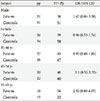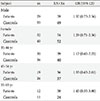1. Morita T, Tabata S, Mineshita M, Mizoue T, Moore MA, Kono S. The metabolic syndrome is associated with increased risk of colorectal adenoma development: the Self-Defense Forces health study. Asian Pac J Cancer Prev. 2005. 6:485–489.
2. Khan RM, Ch TS, Ahmad M, Pash MM. Assessment of awareness about diabetes mellitus among adult populace of lahore: a preventive approach required to combat the disease in Pakistan. Pak J Med Health Sci. 2009. 3:121–124.
3. Rodriguez-Gutierrez R, Gonzalez-Saldivar G, Gonzalez-Gonzalez JG. Diagnosis of diabetes. N Engl J Med. 2013. 368:192–193.
4. Zhang Y, Howard BV, Cowan LD, Yeh J, Schaefer CF, Wild RA, Wang W, Lee ET. The effect of estrogen use on levels of glucose and insulin and the risk of type 2 diabetes in american Indian postmenopausal women: the strong heart study. Diabetes Care. 2002. 25:500–504.
5. Speer G, Cseh K, Winkler G, Vargha P, Braun E, Takacs I, Lakatos P. Vitamin D and estrogen receptor gene polymorphisms in type 2 diabetes mellitus and in android type obesity. Eur J Endocrinol. 2001. 144:385–389.
6. Di Croce L, Bruscalupi G, Trentalance A. Independent behavior of rat liver LDL receptor and HMGCoA reductase under estrogen treatment. Biochem Biophys Res Commun. 1996. 224:345–350.
7. Yaich L, Dupont WD, Cavener DR, Parl FF. Analysis of the PvuII restriction fragment-length polymorphism and exon structure of the estrogen receptor gene in breast cancer and peripheral blood. Cancer Res. 1992. 52:77–83.
8. Golkhu S, Ghaedi M, Taghvaie NM, Boroumand MA, Davoodi G, Aminzadegan A, Poorgoli L, Fathollahi MS. Genetic polymorphisms of estrogen receptors in Iranian women with diabetes and coronary artery disease. Iran J Med Sci. 2009. 34:208–212.
9. Kuiper GG, Carlsson B, Grandien K, Enmark E, Haggblad J, Nilsson S, Gustafsson JA. Comparison of the ligand binding specificity and transcript tissue distribution of estrogen receptors alpha and beta. Endocrinology. 1997. 138:863–870.
10. Jeong JY, Jeoung NH, Park KG, Lee IK. Transcriptional regulation of pyruvate dehydrogenase kinase. Diabetes Metab J. 2012. 36:328–335.
11. Dunning AM, Healey CS, Pharoah PD, Teare MD, Ponder BA, Easton DF. A systematic review of genetic polymorphisms and breast cancer risk. Cancer Epidemiol Biomarkers Prev. 1999. 8:843–854.
12. Shearman AM, Cooper JA, Kotwinski PJ, Miller GJ, Humphries SE, Ardlie KG, Jordan B, Irenze K, Lunetta KL, Schuit SC, Uitterlinden AG, Pols HA, Demissie S, Cupples LA, Mendelsohn ME, Levy D, Housman DE. Estrogen receptor alpha gene variation is associated with risk of myocardial infarction in more than seven thousand men from five cohorts. Circ Res. 2006. 98:590–592.
13. Tanaka Y, Sasaki M, Kaneuchi M, Shiina H, Igawa M, Dahiya R. Polymorphisms of estrogen receptor alpha in prostate cancer. Mol Carcinog. 2003. 37:202–208.
14. Tempfer CB, Schneeberger C, Huber JC. Applications of polymorphisms and pharmacogenomics in obstetrics and gynecology. Pharmacogenomics. 2004. 5:57–65.
15. Molvarec A, Nagy B, Kovacs M, Walentin S, Imreh E, Rigo J Jr, Szalay J, Fust G, Prohaszka Z, Karadi I. Lipid, haemostatic and inflammatory variables in relation to the estrogen receptor alpha (ESR1) PvuII and XbaI gene polymorphisms. Clin Chim Acta. 2007. 380:157–164.
16. Penolazzi L, Lambertini E, Aguiari G, del Senno L, Piva R. Cis element 'decoy' against the upstream promoter of the human estrogen receptor gene. Biochim Biophys Acta. 2000. 1492:560–567.
17. Zarei S, Bigizadeh S, Pourahmadi M, Ghobadifar MA. Chronic pain and its determinants: a population-based study in Southern Iran. Korean J Pain. 2012. 25:245–253.
18. Ganasyam SR, Rao TB, Murthy YS, Jyothy A, Sujatha M. Association of estrogen receptor-alpha gene & metallothionein-1 gene polymorphisms in type 2 diabetic women of andhra pradesh. Indian J Clin Biochem. 2012. 27:69–73.
19. Matsushita H, Kurabayashi T, Tomita M, Tanaka K. Effects of vitamin D and estrogen receptor gene polymorphisms on the changes in lumbar bone mineral density with multiple pregnancies in Japanese women. Hum Reprod. 2004. 19:59–64.
20. Huang Q, Wang TH, Lu WS, Mu PW, Yang YF, Liang WW, Li CX, Lin GP. Estrogen receptor alpha gene polymorphism associated with type 2 diabetes mellitus and the serum lipid concentration in Chinese women in Guangzhou. Chin Med J (Engl). 2006. 119:1794–1801.
21. Araujo KL, de Rezende LCS, Letícia Soncini, Daltoe RD, Madeira KP, Paes MF, Herkenhoff FL, Range LB, Silva IV. Prevalence of estrogen receptor alpha PvuII (c454-397T>C) and XbaI (c454A>G) polymorphisms in a population of Brazilian women. Braz Arch Biol Technol. 2011. 54:1151–1158.
22. Newton KM, LaCroix AZ, Heckbert SR, Abraham L, McCulloch D, Barlow W. Estrogen therapy and risk of cardiovascular events among women with type 2 diabetes. Diabetes Care. 2003. 26:2810–2816.
23. Xiang K, Wang Y, Zheng T, Jia W, Li J, Chen L, Shen K, Wu S, Lin X, Zhang G, Wang C, Wang S, Lu H, Fang Q, Shi Y, Zhang R, Xu J, Weng Q. Genome-wide search for type 2 diabetes/impaired glucose homeostasis susceptibility genes in the Chinese: significant linkage to chromosome 6q21-q23 and chromosome 1q21-q24. Diabetes. 2004. 53:228–234.
24. Cutolo M, Sulli A, Seriolo B, Accardo S, Masi AT. Estrogens, the immune response and autoimmunity. Clin Exp Rheumatol. 1995. 13:217–226.
25. Dahlman I, Vaxillaire M, Nilsson M, Lecoeur C, Gu HF, Cavalcanti-Proenca C, Efendic S, Ostenson CG, Brismar K, Charpentier G, Gustafsson JA, Froguel P, Dahlman-Wright K, Steffensen KR. Estrogen receptor alpha gene variants associate with type 2 diabetes and fasting plasma glucose. Pharmacogenet Genomics. 2008. 18:967–975.
26. Brandi ML, Becherini L, Gennari L, Racchi M, Bianchetti A, Nacmias B, Sorbi S, Mecocci P, Senin U, Govoni S. Association of the estrogen receptor alpha gene polymorphisms with sporadic Alzheimer's disease. Biochem Biophys Res Commun. 1999. 265:335–338.
27. Jeng MH, Shupnik MA, Bender TP, Westin EH, Bandyopadhyay D, Kumar R, Masamura S, Santen RJ. Estrogen receptor expression and function in long-term estrogen-deprived human breast cancer cells. Endocrinology. 1998. 139:4164–4174.
28. Albrink MJ, Meigs JW. The relationship between serum triglycerides and skinfold thickness in obese subjects. Ann N Y Acad Sci. 1965. 131:673–683.
29. Pollare T, Lithell H, Berne C. Insulin resistance is a characteristic feature of primary hypertension independent of obesity. Metabolism. 1990. 39:167–174.
30. Sand P, Luckhaus C, Schlurmann K, Gotz M, Deckert J. Untangling the human estrogen receptor gene structure. J Neural Transm. 2002. 109:567–583.
31. Deng HW, Li J, Li JL, Johnson M, Gong G, Recker RR. Association of VDR and estrogen receptor genotypes with bone mass in postmenopausal Caucasian women: different conclusions with different analyses and the implications. Osteoporos Int. 1999. 9:499–507.
32. Daga A, Fabbi M, Mattioni T, Bertolini S, Corte G. Pvu II polymorphism of low density lipoprotein receptor gene and familial hypercholesterolemia. Study of Italians. Arteriosclerosis. 1988. 8:845–850.
33. Kikuchi T, Hashimoto N, Kawasaki T, Uchiyama M. Association of serum low-density lipoprotein metabolism with oestrogen receptor gene polymorphisms in healthy children. Acta Paediatr. 2000. 89:42–45.









 PDF
PDF ePub
ePub Citation
Citation Print
Print



 XML Download
XML Download